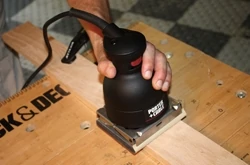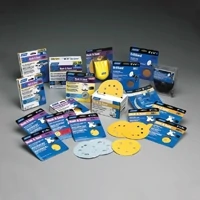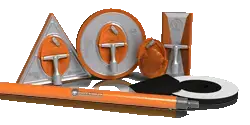The Right Tools, the Right Techniques
By Matt Weber
Sanding is the foundation of any finishing project—or refinishing project. Whether you’re removing an old finish or preparing a piece of fine furniture, just about any project that involves wood requires sanding. For very large jobs like refinishing a floor, you’ll need to rent a large walk-behind drum and disc sander. But for most carpentry and woodworking projects, investing in quality sanding equipment is money well spent.
Sanding tools not only do the job faster than a handful of abrasive paper and whole lot of elbow grease, they also do the job better. For instance, while pine is easy to sand, it’s also easy to damage. The soft wood between the growth rings can wear down quicker than the rings if not sanded correctly. However, a tool as simple as a sanding block can ensure even application of pressure for consistent sanding action over the wood surface. From sponge-backed sanding blocks to heavy-duty belt models, sanders are used for everything from removing house paint to buffing a smooth, glassy finish on an elegant dining room table.
Belt Sanders
For the most aggressive material removal, your go-to tool is a powered belt sander. This high-production tool will quickly smooth down and level a surface, as well as remove paint or glue lines. As with any power tool, more power produces more work and faster cutting. Amperage can range from 5 to 11 in most handheld models. The speed of the belt can range from 700 to more than 1,500 feet per minute, and belt speed also factors into cutting power. Portable sanders usually offer belt sizes running from 3-by-18- to 4-by-24 inches.
Notably, Porter-Cable recently bucked the trend in belt sander size by offering a 2-1/2-by-14-in. model, the 371. It includes an auxiliary handle and dust port, but when these accessories are removed the compact 371 sander measures only about 9 inches.
Its textured rubber grip and low center of gravity allows easy one-handed control when sanding vertical surfaces as when scraping paint off metal and wood, flush-sanding against perpendicular surfaces, etc.
The large 4-in. wide and 3-by-24-in. belt sanders may be the best selection for sanding large, flat surfaces. However, the downside of the size lies in the tool’s weight and maneuverability. Large single-speed sanders can also prove too aggressive for delicate jobs. The big boys can quickly remove a lot of material to the point that the user can accidentally damage a work surface.
Keep in mind that all belt sanders are unidirectional. This means that if you work them from side to side you’ll get some ugly across-grain cuts on the wood surface.
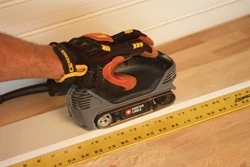
Features to consider on belt sanders include variable speed control, which affords more control of the sanding action. Another design feature to consider regarding belt sanders is the ability to flush-sand right up against the edge of an obstruction. Flush-sanding reduces the chore of hand-sanding against corners.
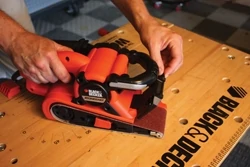
Black and Decker’s 7-amp Dragster belt sander takes its flush-sanding capability a step further. Not only can the nose of this low-profile sander slip into tight spaces, but the front guard flips out of the way to allow sanding with the top of the belt loop, for work in small nooks and between balusters.
Also, look for an easy-to-change belt system. Ideally you’ll get a nice balance between easy changing and consistent belt tracking (the belt’s ability to stay on the platen and wheels during operation). For example, Skil offers the consumer-grade 6-amp, 3-by-18-in. Sandcat with an auto-tracking feature, and its belt is super-simple to change thanks to an easy side lever.
Disc Sanders
After you’ve knocked down the old surface with your belt sander, it’s time to move along to the finishing stages. The popular random orbital sanders use abrasive discs with an oscillating action to remove material with less aggression than belt sanders but more than straight-line finish sanders. Random-orbits are a great intermediate sander for removing any belt-sander marks and preparing the surface for finish. Use these sanders with progressively finer grits of abrasiveness. The abrasive discs may be held onto the sander by adhesive or with hook-and-loop. Choose from sanders with either a palm-grip or pistol-style handle, whichever you find more comfortable.
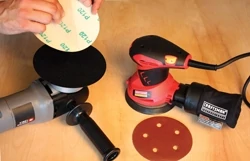
You’ll find options in disc-sander size, usually in 5- or 6-in. options. The new Craftsman 3-amp 27675 random orbit sander is built for professional use and uses 5-in. abrasives that mount with hook-and-loop interface. It offers variable speed from 5,000 to 12,000 OPM (no-load speed) and is engineered with a counter-balance system to reduce tool vibration for smoother sanding action. The popular 5-in. size makes the 27675 sander lightweight and easy to control.
In the 6-in. category, the Porter-Cable 7346SP offers variable speed between 2,500 and 6,800 OPM powered by a 4.5-amp motor. This contractor-tough sander uses peel-and-stick adhesive discs and is built with 100-percent ball-bearing construction. The counter-balanced 7346SP has a two-position auxiliary handle (right or left) and includes a polishing pad.
You’ll find that certain professional-grade orbital sanders from companies such as Festool offer variable sanding motion. These models include a dual-action switch—random orbital for fine sanding, and gear-driven rotary orbital motion for rough material removal.
However, as handy as the disc-style orbital sanders are for the pro and DIY woodworker, the rotary action typically leaves tiny swirl marks on the surface of the wood. These tiny marks may be difficult to see with the naked eye but become considerably more prominent when highlighted with wood finish. That’s why finish sanding is so important.

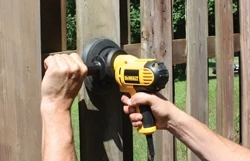
Finish Sanding
Finishing sanders usually operate with a straight-line or vibrating action. They may be large half-sheet sanders or the more common quarter-sheet sanders. Typical finish sanders have the ability to accept virtually any type of sandpaper, just cut to size if necessary and clamp on the abrasive sheet. Some smaller “palm” finish sanders feature dust-extraction holes and require hook-and-loop sanding pads.
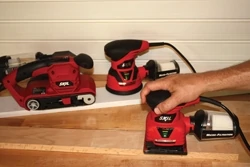
The finish-sanding process begins with medium- to fine-grit abrasive paper used in successive passes over the work surface, progressing to finer grits with each pass until the surface is smooth enough to apply a final stain or other wood coating.
Detail sanders are basically finish sanders with narrow tips or special accessories for accessing hard-to-reach spaces. The Skil Octo detail sander can be equipped eight different sanding profiles, allowing you to access tight corners, flat faces and numerous shapes and profiles.
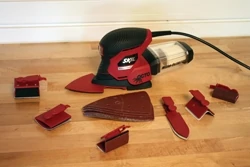
Similarly, the Black & Decker’s Mouse, which is as small and as lightweight as the name would suggest, contains the three most popular accessory profiles for detail sanding. Detail sanders come in handy when trying to smooth out various corners and rounded profiles.
Although finish sanders do a good job of removing the tiny swirl marks left by orbitals, I always prefer to finish off with a good hand-sanding with a very fine abrasive (180- to 220-grit). Use the sandpaper on a rubber or other soft-backed sander, sanding in the direction of the grain. Hand sanding simply affords you better control of the finishing touches. Once sanded, clean away any dust with a tack cloth or vacuum before applying a finish.


Stationary Sanders
Serious woodworkers should consider stationary or “bench” sanders. This tool group of sanders consists of disc, belt and drum sanders, with disc and belt sanders often combined into a single tool. Stationary models are ideal for furniture and cabinetry construction. Much like a table saw differs from a handheld saw, with a stationary sander the work piece is fed into the tool rather than the operator moving the tool over the work piece. This method of sanding can afford greater control of tricky, targeted sanding tasks. Bench sanders can be used to shape and smooth convex or concave surfaces like butcher-block countertop edges, cabriole legs, scroll work and other contoured items.
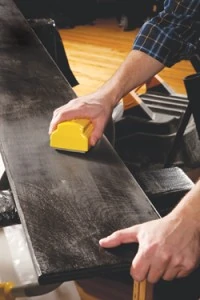
The Skil 3376 benchtop belt/disc sander is small in size yet powerful enough to tackle most shop sanding tasks. The 4-amp 3376 is sturdy and versatile, featuring tension-spring adjustment for secure belt tracking.
You can tilt the 4-by-36-in. belt from horizontal to vertical for sanding at 0 and 90 degrees.
The beveling table top mounts to the belt or the disc for a working range of 45 to 90 degrees. Use the miter gauge in the slotted table top for greater control and more accurate sanding.
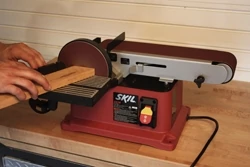
Dust Collection
Some sort of dust-collection device, be it a cartridge or cloth bag, is usually a standard feature on today’s sanders. The newer cartridge-style filters tend to collect more dust than the bags.
And, some sanders have ports that can be connected to a shop vacuum. I’ve yet to encounter an on-tool dust collector that does a perfect job, but I suppose that any decrease in mess is a help. You should always expect some fallout and the required cleanup.
If you spend a lot of time sanding or handling working indoors, you’re best bet is to invest in a dedicated vacuum dust-collection system that attaches to your sander’s dust port via a vacuum hose. The vacuum-based collection systems are the closest thing you’ll find to a dust-free sanding operation.
Side Note 1
Norton is a manufacturer of abrasives for all sanding, cutting, grinding and finishing applications across many markets. The Norton 3X flagship product is billed as the highest quality abrasive line on the market, providing the fastest cut, longest life and superior surface finish either in DIY hand sanding or random orbital sanding. The abrasives won’t tear, clog or transfer color. Norton’s Premium 5X Sanding Sponges utilize superior grain technology with multiple sponge sizes and grit combinations to offer maximum versatility and flexibility on curved, contoured or flat surfaces that sandpaper can’t easily reach. Just rinse and reuse for longer life. Visit Norton Abrasives at https://www.nortonabrasives.com/en-us/markets/home-leisure
Side Note 2
Full Circle Wall Sanders
Full Circle International offers professionals innovative tools for finishing drywall and prepping for paint. The company’s signature Radius360 Sanding Tool has a round, no-flip design and a 9-in.diameter head, providing unparalleled range of motion and finish quality. The recently redesigned Radius360 is the same great tool with the added ability to transform your pole sander to a handheld sander.
The Flex Edge Sanding Tool is a much improved version of the traditional rectangular sanding tool. Designed with a low center of gravity and a rubber and foam pad, this tool has shock absorption, much like the sole of your shoe, offering the end user more detailed pressure when sanding. The Flex Edge won’t give you the coverage of the Radius360 but it is great for sanding corners and small areas and between coats of drywall.
Full Circle’s newest addition to the sanding line is the Trigon180 Sanding Tool. This tool is a hybrid of the Radius360 and the Flex Edge. The triangular head of the Trigon180 has the no-flip, large surface sanding ability of the Radius360, combined with the shock absorption and corner sanding capabilities of the Flex Edge. This versatile tool can also be converted to a hand held sander via the cam-lock mechanism of the Pro Handle Adapter. Learn more at www.fullcircleinternational.com.


